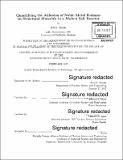Quantifying the adhesion of noble metal foulants on structural materials in a Molten Salt Reactor
Author(s)
Tanaka, Reid S
DownloadFull printable version (17.57Mb)
Other Contributors
Massachusetts Institute of Technology. Department of Nuclear Science and Engineering.
Advisor
Michael P. Short.
Terms of use
Metadata
Show full item recordAbstract
As discovered during the Molten Salt Reactor (MSR) Experiment (MSRE), selected fission products deposited on the wetted surfaces throughout the reactor. Fission products such as molybdenum and ruthenium are noble with respect to the electrochemical potential of the fluoride fuel salt and therefore remain insoluble in their elemental forms rather than becoming ionic salts. Coalescing in the primary fluid, these noble metals then migrate and eventually deposit on internal reactor surfaces. Since the bulk of these noble metal fission products are also energetically unstable they bring not only physical fouling, but heat and radiation from decay as well. The adherence forces of five of the seven principal radioactive foulants discovered during the MSRE were measured on six different potential structural materials by atomic force microscope force spectroscopy (AFM-FS). The noble metals studied were niobium, molybdenum, ruthenium, antimony and tellurium. Structural materials measured were Hastelloy-N, the primary structural metal of the MSRE; two steels, SS316L and F91; commercially pure nickel and molybdenum; and silicon carbide. MSRs operate with surfaces free of passivating corrosion layers, so the measurements were conducted on bare metal surfaces. An argon ion gun chamber was constructed for removal of the oxide layers from mechanically polished substrate metals by sputtering. A combination vacuum chamber/glove box was crafted to accept the sputter polished substrates into a dry, inert environment where the force adhesion measurements were made. Data acquired in the last phase of the study partially demonstrated the concept. The measured particle-to-substrate attractive forces found antimony and tellurium to be generally more adherent to the bare metals than niobium or molybdenum. The finding is consistent with the fouling examined in the MSRE. If held, this correlation of laboratory measurement to actual fouling may aid the reactor designer in anticipating fouling to plan for the effects. Such knowledge would inform selection of plant materials, both for operating components such as flow detectors and heat exchangers, where fission product deposition would be undesired, and for processing components such as filters and metal collection systems, where adhesion would be preferred.
Description
Thesis: S.M., Massachusetts Institute of Technology, Department of Nuclear Science and Engineering, 2017. Cataloged from PDF version of thesis. Includes bibliographical references (pages 145-149).
Date issued
2017Department
Massachusetts Institute of Technology. Department of Nuclear Science and EngineeringPublisher
Massachusetts Institute of Technology
Keywords
Nuclear Science and Engineering.